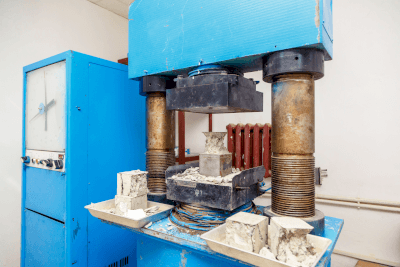What Is a Compression Tester?

Compression testers check a member’s behavior by applying a force to it in the direction of compression or measuring its physical properties by causing it to fail in compression.
Mainly, it can continuously measure the force and displacement generated during the test over a predetermined period.
Some testers can perform tests in the tensile direction by changing the direction of the load cell (the sensor that measures force).
A wide range of testing machines is available from various companies, from compact tabletop testing machines (measuring a few N) to testing machines used for crushing concrete and metal (measuring several thousand kN).
Uses of Compression Testers
Compression testers are used to check the physical properties of materials under compression in basic research at laboratories and material manufacturers and for destructive testing under compression at industrial manufacturers.
The testing machines are often available at industrial research institutes and industrial testing facilities. They can be used at a relatively low cost (several thousand yen per hour) compared to the cost of purchasing a testing machine by applying for their use.
In many cases, an industrial testing laboratory can handle the testing equipment with advanced arrangements. Such as, when the workpiece is simple and portable, no special jigs or tools are needed for workpiece installation, the testing conditions (head speed, assumed stroke) have already been determined, and the number of workpieces is fixed.
Principles of Compression Testers
The compression tester consists of a base on which a workpiece is installed, a movable part to which a load cell is attached at the top, and a PC or touch panel to capture the measured values of the load cell.
The controller or PC operates the machine, moves the movable part down, clamps the workpiece between the base and the movable part, and applies a force in the compression direction. It is possible to measure the pressure generated in the compression direction by measuring the applied pressure with a load cell.
From the position data of the moving part and the load data of the load cell, it is possible to determine the compression characteristics of the workpiece. For example, for brittle materials such as carbon steel, it is possible to measure the compressive modulus of elasticity and failure load up to the point of compressive failure. The compressive modulus of elasticity, failure load, yield load, etc., can be measured for ductile materials such as copper. This is made possible because several to several dozen points of position and load data can be acquired in one second during the test, starting immediately after the test and continuing until the end of the test.
These test data can also be checked numerically and visualized graphically on the system’s interface.